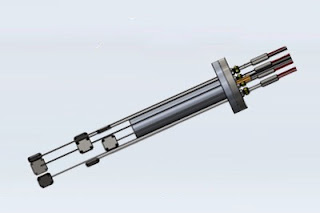 |
| Example of an integrated heater and thermowell with multiple sensors to be matched with a control system for highly accurate heating. Courtesy of BCE. |
Temperature gradients and fluctuations occur during heat up, cool down, and when process load is applied. These are mitigated by proper placement of the heating source, location of the sensing element, and control mode chosen.
Thermal system stability is maintained by carefully balancing the energy applied to the process media in opposition to the energy adsorbed by the process and all the radiant, conductive, and convective losses in the system.
For example, an electric heater's "power" is rated in watts, and the power density is stated in watts per square inch. In an ideal thermal system, the energy provided by the electric heater (in watts) would equal the energy lost from all the surfaces and work-related losses at the desired temperature. However, the world is not ideal, and additional external variables affect close temperature control. Hence, the need for control systems.
Control systems regulate in two ways: 1) by regulating the amount of energy (electricity or fuel) added to a process; and 2) by regulating the time the full energy source is applied. When talking about electric heaters, an example of power regulation is the use of thyristor power controllers that modulate the voltage delivered to the heater. An example of time-based power control is the use of solid state (or mechanical) relays and proportioning the amount of time-on, versus time-off, that full power is applied.
Recommendations for optimal thermal system control:
- Use adequate insulation when and where possible to reduce radiant and convective surface losses.
- Design the thermal system with the heating source, sensing element and process media as compact and near one another as possible.
- For thermal systems that are likely to have large overshoot, consider using cascading control that governs the power output based upon multiple sensing locations.
- Carefully consider the thermal system control mode you choose for the application, i.e. simple on-off control or some variety of energy proportioning.
- Sensor position is very important. The sensor should be placed as close to, or immersed in, the critical area of your process media, or where a good average temperature can be obtained.
- Consider the thermal conductivity of your process media and base your sensor location accordingly. You may have to test several locations.
Contact BCE with any question or requirement for electric heaters or thermal system design. Call 510-274-1990 or visit https://belilove.com.